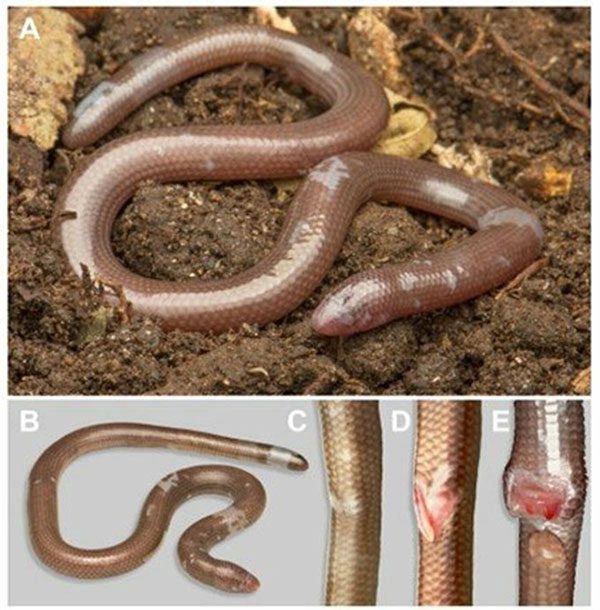A New Species of Blind Lizard Belonging to the Dibamidae Family Discovered in Nui Chua National Park.
The new blind lizard species is scientifically named Dibamus deimontis, named after the location where it was discovered (in Latin, “deimontis” means “Mount Chua”). This species was discovered and described by experts from Vietnam and Russia based on specimens collected during a field survey in 2023 by the Vietnam-Russia Tropical Center at Nui Chua National Park. This is the eighth species of the genus Dibamus recorded in Vietnam. The research was published in the journal Zootaxa in early February.

Morphological characteristics of the species D. deimontis. (Photo: Research Team).
Master Le Xuan Son, from the Vietnam-Russia Tropical Center, stated that the new lizard species has a maximum length of 13.6 cm, an average tail length of about 3.0 cm, and exhibits coloration ranging from gray-brown to pink-brown, with large, irregular gray spots on its body. The external morphology closely resembles that of earthworms. With its characteristic of living hidden in the soil or beneath decaying plant matter, its eyes have nearly degenerated and are completely covered by outer scales. The forelimbs have completely disappeared, and the hind limbs are rudimentary, only present in male specimens. “The presence of small, incomplete grooves on the lips and nose is an important feature to distinguish this species from others in the same genus,” he noted.
The species D. deimontis is differentiated from other species in the same genus by a combination of morphological characteristics, including grooves on the lips, a cleft in the lips and nose; 3 – 5 scales at the posterior edge of the lower lip; 22 – 25 rows of scales along the body; 193 – 225 belly scales; 47 – 55 under-tail scales; 115 dorsal vertebrae and 27 tail vertebrae; with a maximum snout length of 136.2 mm.
Mr. Son added that Dibamus deimontis was described based on 8 specimens collected at an altitude of 670 – 700 meters above sea level, with most specimens found in moist areas near small ponds or streams. They typically hide beneath rocks or on large boulders covered with moss, ferns, and decaying matter. On the same large boulder where this species was discovered, the research team also noted the presence of earthworms, millipedes, centipedes, and several other insect species. “When disturbed, they wriggle continuously to escape from the rock to the ground and quickly hide, similar to earthworm behavior,” he explained.

Head scale characteristics of the species D. deimontis. (Photo: Research Team).
Previously, another species, Dibamus tropcentr, was also described in Nui Chua National Park, Ninh Thuan Province. However, according to Mr. Son, unlike the species D. tropcentr, which was discovered in dry coastal forest habitats at low altitudes (200 – 300 m above sea level), the species D. deimontis was found in humid green forest habitats on the mountain, near the summit of Mount Chua (670 – 700 m above sea level). Although the research team focused on searching in other altitude zones, they did not find any additional specimens of the genus Dibamus.
He stated that to accurately determine the distribution range of these species, further research is necessary. However, it can be initially confirmed that their distribution areas do not overlap. To date, most studies indicate that species of the Dibamidae family are characterized by being narrowly endemic. Therefore, it is very likely that they are only distributed within the habitats where they have been discovered.
“The discovery of the species D. deimontis has provided additional evidence of the diversity of animal species in Nui Chua National Park and highlights the importance of Vietnam as a center of diversity for endemic reptiles in Southeast Asia,” Mr. Son stated.




















































